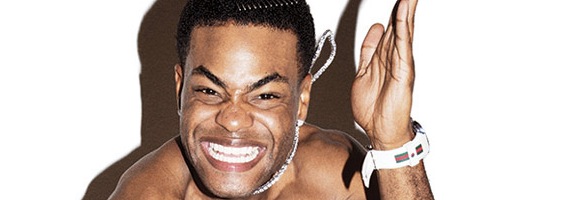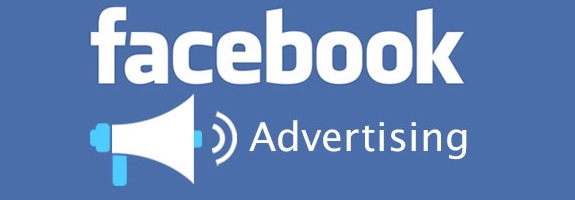A few weeks ago I put out an offer to members of the Connected Comedians Facebook group – I offered to run some Facebook ads for a comedian to promote something they were working on for free.
All the comedian would have to do is cover the costs of a Facebook ad – as much or as little as they wanted to spend – and I’d lend my expertise for free as long as they were ok with me sharing how I did it and the results with other Connected Comedy readers.
I was happy to see there was lots of interest in my offer, and ultimately I chose to work with Chicago comedian Kyle Scanlan who wanted to promote his humor site The Whiskey Journal. (For those of you I didn’t choose, I’m likely to do this again so you’ll have another chance.)
Kyle had $50 to spend on the Facebook ads and didn’t have a specific goal beyond getting more attention for the site, so I decided to split the budget amongst two goals.
I’d spend half of it on an ad designed to get more fans for his site’s Facebook page, and the other half of it to drive traffic to a specific article on the site.
Here’s a breakdown of how I approached it and what happened (Spoiler Alert: It was VERY successful).
Please note that below I focus on the strategy behind running Facebook ads and not the nuts and bolts of how to technically set them up and run them – you can learn about that here.
Ad #1: How To Get More Facebook Fans
The first ad I set up was designed to get new fans for the Whiskey Journal Facebook page.
It can be challenging to get fans for a Facebook page – especially when it’s for a broad site like the Whiskey Journal, where the topics covered are really all over the place.
It was additionally challenging in this case because the name of the site doesn’t really convey what it is, and in fact can be misleading. If somebody sees a site called The Whiskey Journal in their feed, they don’t immediately think it’s a comedy site – they’re more likely to think it has something to do with liquor.
Regardless, we weren’t about to change the site’s name so I turned my attention to how best to play the hand I was dealt.
In creating a Facebook ad strategy, there’s really two key components to consider – who you’re going to target and what you’re going to target them with.
Step 1: Choosing Who To Target
I noticed that the page already had a couple thousand fans which was a great start and something that could be leveraged in the Facebook ad targeting. Also, even though the site’s content is pretty broad, there was still an underlying niche in that its tone was similar to some really popular news parody sites like The Onion.
I also assumed based on the content and its writers, that men might be more likely to enjoy the site than women so I figured I could focus the ad that way as well.
One other thing I always do when I run ads is have them run only in people’s news feed – by default Facebook runs ads in the news feed AND on the right sidebar of pages. But I personally believe that nobody pays attention to the sidebar and those ads are a waste of money, so I uncheck that box to ensure that my ads only run in the news feed itself.
So based on these thoughts, here’s the targeting I came up with for the ad:
 This means that the only people who would ever see my ad would be people who I believe are most likely to actually like the page – they would be friends of people who already like the page, they would be men, they would be people who already like or talk about The Onion, and I’d only pay for ads that appeared in their news feed, where’s they’re most likely to notice them.
This means that the only people who would ever see my ad would be people who I believe are most likely to actually like the page – they would be friends of people who already like the page, they would be men, they would be people who already like or talk about The Onion, and I’d only pay for ads that appeared in their news feed, where’s they’re most likely to notice them.
Step 2: Choosing The Ad Creative
With my targeting in mind, I then thought through what the ad should look like and say.
While you have somewhat limited options, there’s actually a lot you can control including the caption and image that runs with the Page name (which you can’t change when promoting a page).
Keeping my targeting in mind, I wanted to create something with an image that would grab people’s attention (they have to notice your post in order to even have a chance of getting them to like it) and convey something funny, combined with a caption that helped amplify what I thought were the key selling points of my targeting.
Here’s what I came up with:
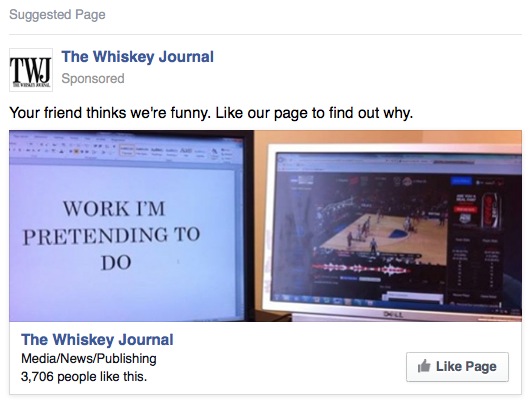 You’ll notice that the image I chose (one which I found on a post on the site) is a joke in itself. My hope was that people would notice it, get a laugh, and that would encourage them to at least check the page out. And maybe some people might even hit the “Like Page” button thinking they were just liking the image – an honest mistake that could also get us some extra new fans.
You’ll notice that the image I chose (one which I found on a post on the site) is a joke in itself. My hope was that people would notice it, get a laugh, and that would encourage them to at least check the page out. And maybe some people might even hit the “Like Page” button thinking they were just liking the image – an honest mistake that could also get us some extra new fans.
I always try to keep captions as simple as possible – less is more.
In this case, I knew that most people seeing this ad will never have heard of The Whiskey Journal before, but I knew that because of my targeting they will be people whose friends already like the page. So, I tried to use that to my advantage – providing some social proof (your friend likes it, so it must be decent) as well as inspiring curiosity (don’t you want to know why your friend likes this thing you’ve never heard of?).
The resulting caption line I came up with – “Your friend thinks we’re funny. Like our page to find out why.” – accomplishes both of those things in as simple a way as possible.
The Results
So, how did it work? It wasn’t the most amazing performance I’ve ever had with an ad, but overall I was pretty happy with the results considering the inherent challenges in the title of the page and promoting a page for a website few people were familiar with.
Here’s the breakdown of how it performed:
$24.89 spent
2,442 people reached (this is the number of people who saw it in their news feed)
54 clicks (that represents a 1.7% clickthru rate)
42 Page Likes (this means it generated 42 new fans for the page)
59 cents cost per new fan
So basically, for $25, I got Kyle 42 new Facebook fans. Ultimately, it’s up to you/him to determine whether or not that was worth the spend, but personally I think that’s a solid, if not spectacular, performance.
Speaking of spectacular…let’s move on to the second ad I ran for Kyle.
Ad #2: How To Get More Website Traffic
The second ad I ran was designed to get people to visit the Whiskey Journal website who had never seen it before. Since I only had a $25 budget to work with, I decided to focus my efforts on a single ad leading to a single piece of content on the site.
Kyle didn’t have any specific post he wanted me to promote, so it was up to me to choose whatever I thought would work best. I surfed around the site looking for a post that I thought was not only funny, but would also appeal to a very specific (and targetable) audience.
I came across this article about Derrick Rose that I thought would be a great fit because it not only was funny and likely to appeal to a very specific (and easily targetable) audience, but it even was somewhat topical and controversial. I could see how it might be the kind of thing that people who are frustrated with Rose would want to share and people who are Rose defenders would want to comment on in disagreement.
Remember, there’s value to content that causes a reaction – even if that reaction isn’t necessarily agreement.
Step 1: Choosing Who To Target
After choosing the content I wanted to promote with the ad, I started to think through the audience I wanted to target with it. Since I chose a piece of content that led itself to a somewhat obvious audience, this was easier than determining the targeting for the more generic ad I previously ran for Facebook fans.
As a side note, it should almost always be easier for you to come up with specific targeting for a specific piece of content than it is for an entire website because each piece of content is usually about one specific thing as opposed to a website which may be more all over the map.
In determining who to target, you always want to go as specific as possible – the more specific you get, the better the ad will perform. Also, you want to think about what the content is about as opposed to what you (or your website) are about.
For example, even though Whiskey Journal is a comedy site, this article is about a sports figure – so instead of targeting comedy fans, I’d do better to target sports fans.
This may seem obvious when you think about it, but it’s a huge mistake that most comedians make when running Facebook ads – they think because they’re doing funny stuff that the only people interested in it will be people who are into comedy. You’ll have more success if you focus on the topic of the content, as opposed to comedy in general.
Another place where a lot of people would go wrong with targeting is they might just target people who like sports and be done with it. But again, you want to go as niche as possible and in this case Derrick Rose is a big enough star that I was able to target people who are specifically fans of his.
I even took it a step further by limiting it to men, and limiting it to people who live in Chicago – figuring that those would be hardcore Bulls fans with strong opinions on Derrick Rose.
Again, my goal was to drill down as specifically as possible to increase the chances that the people who saw my ad would be interested in it.
Here’s the targeting I settled on:
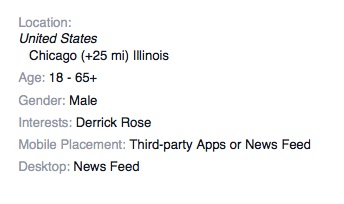
Step 2: Choosing The Ad Creative
The next step was to figure out what I wanted the ad to look like – again keeping in mind who I was targeting and trying to make it as compelling as possible to that audience to drive clicks.
Typically, people just paste in the link to their article and run the ad with whatever image, headline, and description happens to get auto-pulled from the site. That’s a huge mistake and a missed opportunity.
Each of those elements can (and should) be edited to match the people you’re targeting and the goals.
For example, here’s how the link to this article would show up on Facebook by default:
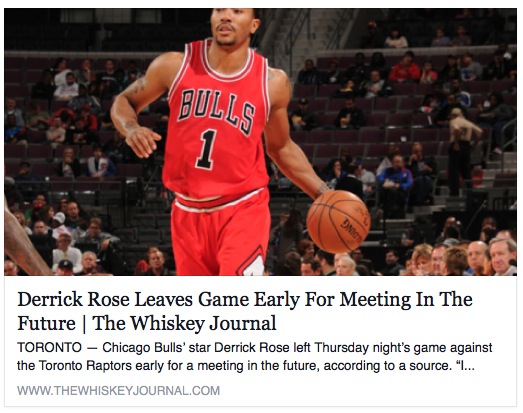
This was ok, but I thought I could do better. Here’s what I created instead:

I changed the headline to something simpler that teased the article and made people curious to see what Rose had said.
It’s a little clickbait-y, but I’m trying to get clicks so that’s not a bad thing. Also, I wrote a short, simple headline that I thought would appeal to people who are frustrated with Rose (they were more likely to enjoy an article parodying him than people who are his fans).
The original headline also kind of functioned as a joke on its own, where my revised headline played more like the setup, with the joke being delivered on the page itself.
I also swapped out the photo with what I thought was a more compelling image I found on Google images. In general, close-up shots of people’s faces perform better than full body shots and I thought the face Rose is making in this image, when combined with the headline, was more attention grabbing than the more generic image of Rose on the court.
These are minor details, but they can make a difference.
Finally, I changed the description and caption to speak to the reader in a conversational tone as opposed to just auto-pulling the first few words of the article. As you can see, that’s a whole different tone and in my opinion makes it much more compelling.
Also, running it as an ad allowed me to add that “Learn More” button which gives an additional call to action to drive clicks. [FYI, I chose the Learn More button from a few pre-set options Facebook provides, it’s not the best language but it was the closest one that fit in this case.]
The Results
This ad wound up performing as good as any ad I’ve ever created. In fact, I’m not sure it’s even possible to have an ad do any better.
Here’s the breakdown of how it performed:
$26 spent
40,043 people reached
4,379 clicks to the website
13.5% clickthru rate (this is insanely high by the way)
1 cent cost per click
That’s right, this ad drove a targeted audience (Derrick Rose fans) to the Whiskey Journal’s Derrick Rose article at a cost of just a penny per click!
The post also generated 65 Likes and 31 shares from the people who saw the ad.
Now, I should mention that not everybody loved the post and some people found it misleading because they clicked expecting it to be a legitimate news story and not an Onion-style parody.
That led to some negative comments on the post pointing out that it was fake, and some other negative comments from people who didn’t get the joke and were mad at the press for ripping Derrick Rose (which is funny in a whole other way).
You can see all the comments on the post here.
But, there were lots of people who did get the joke and found it hilarious – they commented about that, they shared the post, and in some cases left comments calling other commenters dumb for not getting the joke.
Remember – it’s ok if not everybody likes what you do. In fact, they probably shouldn’t.
The “controversy’ of the post actually helped the post do well – remember, even a negative comment counts as engagement in Facebook’s eyes and therefore increases the chances it will show the post to more people.
The goal was to get noticed and to attract some new readers to The Whiskey Journal and this ad did just that.
If 50% of the people that clicked didn’t like what they saw, that doesn’t matter – what matters is the 50% of the people that did like it.
Any Questions?
Ultimately, every ad campaign is different because every person’s goals are different and so is the content they’re trying to promote. But hopefully, this example has helped you see how I think through what to do when I run Facebook ads and you can apply some of that thinking to your own efforts.
I should also add that this was just a small test with a small budget – in general, I always recommend testing different combinations of ads and the more you test, the more you can learn what works best.
These ads worked really well, but could they have been better with different images? With different headlines? With different targeting? Maybe.
That’s why Facebook ads are an ongoing challenge – no matter how great you do, there’s always that chance you could do better.
If you’ve got any questions about any of this or want some advice about promoting your own stuff with Facebook ads, post a comment below or tweet me.



